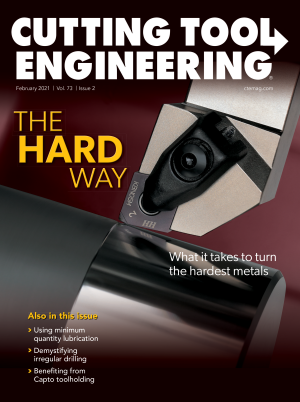The pandemic has forced us to explore new approaches for how we do business in the cutting tool industry. Personal relationships with customers and partners always will be most important. But by embracing modern digital technology, we’ve been put into a position to be cost- and time-efficient in how we maintain those relationships, and we’ve begun to close the gap with other industries in our processes and approach. We learn how to build and maintain customer relationships with and through our technical resources instead of looking at them as a temporary substitute for regular face-to-face meetings.
In a contracting market like this one, it’s never easy to operate. But my perspective is: Let’s take this opportunity to reinvent ourselves and drive the evolution necessary to become a 21st-century business.
My company is developing programs to drive sales growth and strengthen our relationships with customers and key partners while limiting the size of our sales force and restricting the related costs we incur, especially for travel. By training our sales team on the latest digital tools, we prepare it for the future selling environment and help it become more efficient and productive. We’ll never get away entirely from in-person sales, but we have learned that we can develop and maintain important relationships without every meeting being face to face. And we’re finding that customers are open to that and appreciate it because there are also greater demands on their time, and they use more technology every day to manage those demands.

Furthermore, we’re making certain that our selling partners are efficient and productive. We’re training our distributors to be authorities about our products and our customers’ businesses. Through that insight and understanding, we strengthen our customer relationships with each transaction.
Similarly, we’ll never get away completely from printed materials, which are still necessary but not as much as they used to be, especially if relationships are managed digitally. Customers are becoming more accustomed to finding what they need online and are open to digital contacts and interactions.
This crisis has opened a door to be creative, and a lot of customers and partners out there have increased their creativity to meet the demand. So it’s opened our company to much creative thinking about how we do business moving forward.
We’re finding openness now in our industry to research what is needed digitally. People have raised their awareness and are using technology. This is partially a reaction to pandemic restrictions, but it’s also driven by fundamental changes in how manufacturing does business today. So in that regard, we’re already there. We have that option with our Centralized Distribution Center. We have invested in building an industry-leading comprehensive catalog, and now its products are available quickly and conveniently — and digitally — through our CDC. It’s a single-point-of-contact ordering approach that saves valuable time for our customers.
When the pandemic hit, a lot of our competitors viewed the limited direct access to customers with much negativity, but I saw an opportunity. I asked, “How can we leverage this?”
At our corporate and board levels, we’re starting to contemplate, “Well, we’ve been really successful at business in this COVID-19 bubble, so how can we improve and transform our business so all areas incorporate new strategies to meet the needs of modern consumers?”
The more progressive that our business and industry become, the more success we will have with customers and partners.
Progressive, innovative marketing is critical to success. Traditional approaches and even venues won’t necessarily provide the same return on investment as in the past. In this crisis, we reexamined our investment in trade shows. Because of COVID-19, there was no International Manufacturing Technology Show. But ARCH Cutting Tools’ leadership team already had planned to reinvest company money in a more intimate relationship with customers. Suddenly, we were ahead of the game, with many other digitally-driven ways to engage customers that provide the same — or better — return on investment. That’s an example of how our leadership is progressive and open to change and flexibility.
From the standpoint of customers, if we’re going to embrace this digital world and telecommuting, then customer engagement is so terribly important that we need to find innovative, creative ways to digitally/remotely manage these relationships — by people who thrive in that environment.
More than any other company I’ve worked for — especially in the cutting tool business — ARCH Cutting Tools is very decentralized, including our leadership structure. I can work from home or on an airplane — anywhere. Our leaders model our flexibility for adaptive office environments versus traditional brick-and-mortar ones. And this is not just a COVID-19 necessity. Our company has a legacy of this remote work approach, with our leadership and experts dispersed throughout the country. This unique dynamic in our corporate leadership culture has led to a successful business, which is becoming even better because of the digital revolution that we’re embracing.
Research indicates that a decentralized workforce, made up of the right individuals and relying on available digital tools, often devotes more time overall because the workforce is flexible to attend to personal issues between work assignments. This flexibility enhances productivity. Old-school bosses think that work/life balance means “I don’t want to be here.” They believe that there is less devotion to a job if there are still concerns about personal issues. The reality is that when a job cares about workers, they care about the job.
That leads to an additional opportunity for us to evolve. Our industry is undergoing a transition in which there is less need for standard tools and greater need for specials. Because of the demands on their businesses, customers demand more innovation at the spindle: more technically engineered tools. A critical step to satisfy this requirement is evolving a workforce to meet the needs of modern customers.
Contact Details
Related Glossary Terms
- sawing machine ( saw)
sawing machine ( saw)
Machine designed to use a serrated-tooth blade to cut metal or other material. Comes in a wide variety of styles but takes one of four basic forms: hacksaw (a simple, rugged machine that uses a reciprocating motion to part metal or other material); cold or circular saw (powers a circular blade that cuts structural materials); bandsaw (runs an endless band; the two basic types are cutoff and contour band machines, which cut intricate contours and shapes); and abrasive cutoff saw (similar in appearance to the cold saw, but uses an abrasive disc that rotates at high speeds rather than a blade with serrated teeth).



